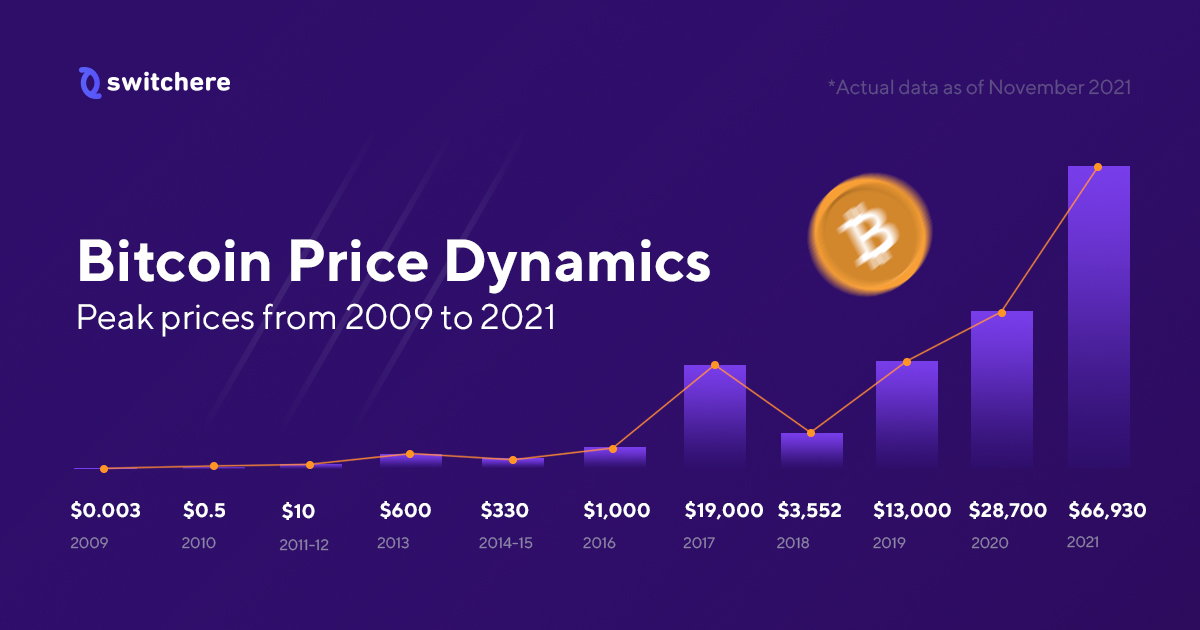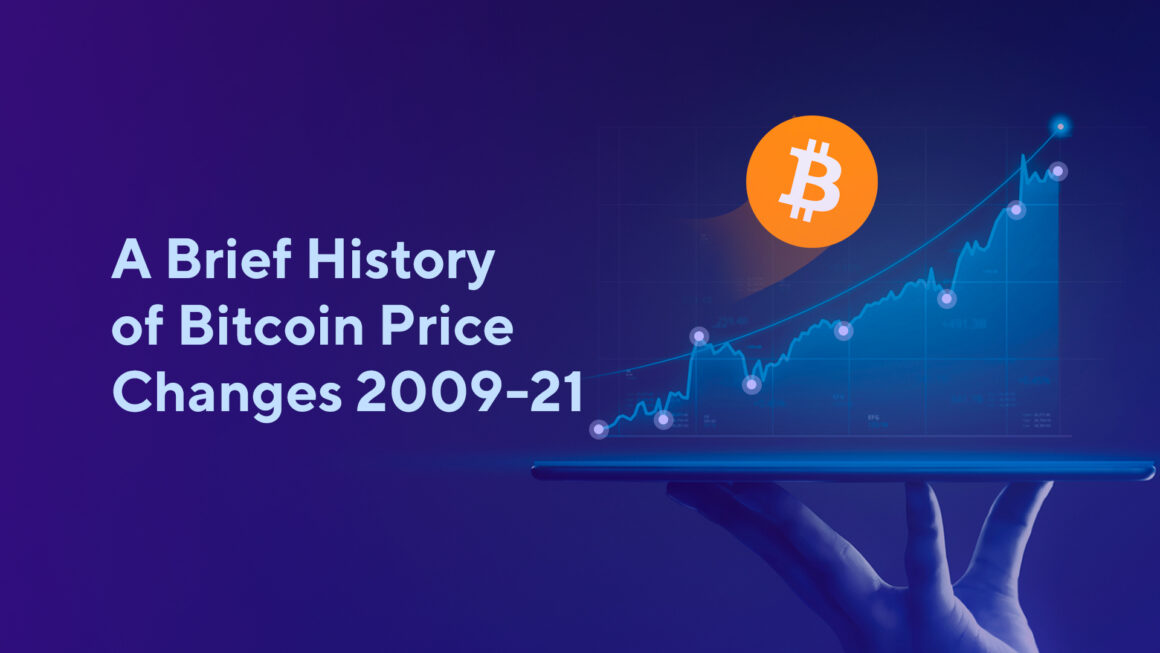Since early 2021, the volatility of Bitcoin has been extremely high. To a person who is not familiar with the cryptocurrency industry, such instability may seem risky. However, to surprise investors even when no one expects it is a common situation for Bitcoin.
In this article, we will recall the main ups and downs of the asset and track the dynamics of the BCT rate from the very moment of its creation to the present day. Let’s get started!
Bitcoin Price History by Years
The history of Bitcoin began in August 2008 when the domain name bitcoin.org was registered. Later that year, someone using the pseudonym Satoshi Nakamoto published a document titled ‘Bitcoin: An Electronic Peer-to-Peer Payment System.’ In it, he described how the future cryptocurrency would work.
In 2009, cryptocurrency mining occurred. However, Bitcoin was not sold anywhere. Then there were no cryptocurrency exchanges at all. Technically, the price of Bitcoin in 2009 was $0.
Here is the chart of Bitcoin’s peak prices from 2009 to 2021. Still, just continue reading for more detailed information!

2010
Throughout 2010, Bitcoin did not manage to reach the $1 mark, but the price started to rise. The funniest event of that year was the moment when the American Laszlo Hanyecz bought two pizzas for 10,000 BTC (then 1 BTC was worth $0.0025). If Laszlo had kept this amount of bitcoins for another ten years, then in 2021, he would have had more than $450 million.
Also, in 2010, the notorious cryptocurrency platform Mt.Gox appeared, which would later become a target for hackers.
2011
2011 was a turning point for BTC: in our history of the BTC rate over the years, it occupies a more prominent place than the notable 2017. First, Bitcoin finally managed to reach the $1 mark. After the highly specialized publications Slashdot and Hacker News wrote about cryptocurrency, Bitcoin.org enjoyed a wave of new users from Twitter.
At the beginning of 2011, some unusual events took place. From February 25 to February 27, the Bitcoin network hashrate increased sharply from 401 GH/s to 628 GH/s. Until March 1, the hashrate dropped to 392 GH/s and then rose to a record 774 GH/s.
What is so unusual about this? The point is that hashrate is an indicator of the speed with which mining hardware in blockchain networks solves a cryptographic puzzle. Simply put, an increase in hashrate means an increase in the number of miners on the market.
Such a sharp jump could be explained by the fact that someone was using a supercomputer or some kind of network bot. It would later be called a ‘mysterious miner’ in the cryptocurrency community. Thus, ‘mysterious miner’ became the reporting point for the gradual growth of the BTC network hashrate, subsequently increasing it to an unimaginable 15.8 TH/s.
On April 16, 2011, TIME first mentioned Bitcoin, devoting an entire article to it with the headline ‘Online Cash Bitcoin Could Challenge Governments, Banks.’ In early June of the same year, the BTC price skyrocketed to almost $32 in six days but then fell to $10.
In the same month, the well-known resource WikiLeaks began accepting donations in bitcoins.
On June 19, 2011, Mt.Gox was hacked, causing the Bitcoin price to fall from $17 to $0.01. It caused financial damage to the accounts of 60K users for a total of more than $8.7 million. A week later, trading on Mt.Gox resumed, and the fall in price after the hack became the largest in the history of Bitcoin.
2012
By 2012, the price of Bitcoin dropped to $4.6 but recovered to $13.44 within a year. In the same year, the first halving in the history of Bitcoin took place.
2013
In 2013, Bitcoin reached the $1,000 mark. On November 30, 2013, the BTC price rose to its first impressive maximum of $1,153. BTC repeated it only a few years later — on January 5, 2017.
2014 & 2015
After an excellent 2013 year for the cryptocurrency industry, a culminating event in the criminal history of Bitcoin took place. In February 2014, the Mt.Gox site was hacked again. This time 744K bitcoins were stolen — this is an absolute record and the largest exchange hack to date.
As a result of the hack, Mt.Gox filed for bankruptcy, creating panic in the Bitcoin market. From that moment, the first prolonged decline of BTC price began commonly called the cryptocurrency winter.
2016
2016 was marked by another halving, the first Bitfinex hack with 120K bitcoins stolen and the announcement of Craig Wright, who proclaimed himself Satoshi Nakamoto. By the way, Wright is still suing the Bitcoin Core and Bitcoin Cash developers, who deprived him of access to two crypto wallets as a result of the Mt.Gox hack.
2017
It is a turning point in the history of the BTC rate. At the beginning of 2017, Bitcoin was still worth $960. In September, it reached the $5,000 mark, and on December 17, the peak of the BTC price was recorded at the $19,483 mark. The market cap of Bitcoin that year exceeded $330 billion.
2018
At the beginning of the year, Bitcoin was worth $13,800 — and this was the maximum price per coin at the time. By the end of the year, it was trading at about $3,800. This year was remembered for the BTC crash and the following cryptocurrency winter. On January 17, 2018, the coin rate fell to $9800. On January 30, Facebook, Twitter, and Google banned advertising of cryptocurrencies, ICOs, and binary options on their platforms. After that, the BTC price continued to fall.
In the summer of the same year, Facebook reconsidered its attitude towards the prohibition of cryptocurrency advertising and allowed it, but after moderation. However, this did not help the coin market recover in value.
By the end of 2018, the BTC rate fell by almost 80% compared to the same period in 2017. Miners started to sell their hardware and mining farms, as they brought losses.
2019
In June 2019, Bitcoin tried to overcome the bearish crisis but failed to cope with resistance at the level of $13,785. Legal issues, the US Securities and Exchange Commission (SEC) struggle with the Bitcoin-ETF and hopes to launch institutional BTC service Bakkt became the main topic in the community.
Bakkt finally launched in September but did not attract much attention from institutional investors, triggering a drop from $10,036 to $6,657 in just a couple of months.
2020
The year 2020 allowed the cryptocurrency market to stabilize and grow, despite the worldwide economic crisis associated with the Coronavirus. Bitcoin and other cryptocurrencies seemed to go against all traditional assets and rallied when the markets fell.
In January, BTC traded for $7.2K, in February — for $10.5K, but then a sharp drop to $3.8K followed. During the year, the price rose, and in December 2020, the coin was worth around $19,000.
There were several reasons for Bitcoin’s massive growth. First, the money supply of the US dollar had grown by 22%. And since the business activity significantly declined due to the Coronavirus, this led to a devaluation of the currency.
Against this background, institutional investors began to invest in Bitcoin. Thus, the Ruffer company invested 2.5% of its assets in the coin. In a letter from the British investment fund to its investors, it was said that this step was needed as insurance against the devaluation of world fiat currencies.
In 2020, one of the largest payment systems, PayPal, allowed using cryptocurrencies for payments on its platform. This solution met with huge demand, so that the company had to increase the limit on operations several times.
2021
The growth of the very first cryptocurrency continued in 2021. Moreover, Bitcoin was setting value records almost every month. In mid-January, 1 BTC cost $40,700, on February 20, the peak price was $57,600, on March 13 — $61,100, on April 13 — $63,600.
However, after that, BTC fell by $14K — the coin was trading at $49.2K, and it had increased to $51.3 by mid-May. On May 17, Bitcoin was worth around $42.5K.
The volatility of BTC largely depends on the news of companies and banks. Tesla announced that it had bought bitcoins worth $1.5 billion — the price increased. Shortly thereafter, the company changed its mind about accepting bitcoins as a means of payment — the value of BTC decreased by 10%.
But still, the situation has changed significantly in recent months. On October 20, the price of Bitcoin renewed its mid-April all-time high and exceeded almost $67,000.
Bitcoin rate rose sharply after the first exchange-traded fund (ETF), based on Bitcoin futures of the Chicago Mercantile Exchange (CME Group), began trading in the United States on October 19. The current BTC price is $61,904.
Conclusion
Will the situation change significantly in 2022? Well, only time will tell. Today, we have considered the history of BTC price changes.
If you’re interested in buying BTC, you should definitely think about doing this at Switchere. On our platform, you have an opportunity to buy BTC in the fastest and most convenient way using your credit card. Moreover, we offer some surprising bonuses! Users of our platform enjoy a 0% service fee for the first order.

Leave a Reply